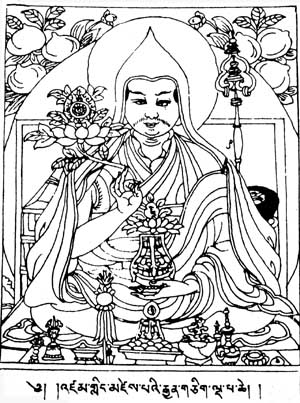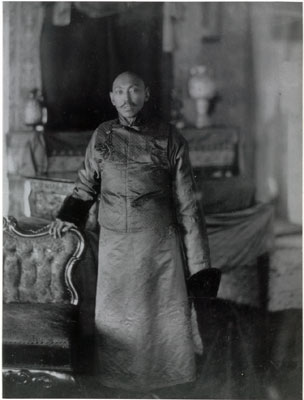
Bhutan's early history is steeped in mythology and remains obscure. Some of the structures provide evidence that the region has been settled as early as 2000 BC. According to a legend it was ruled by a Cooch-Behar king, Sangaldip, around the 7th century BC, but not much is known prior to the introduction of Tibetan Buddhism in the 9th century, when turmoil in Tibet forced many monks to flee to Bhutan. In the 12th century, the Drukpa Kagyupa school was established and remains the dominant form of Buddhism in Bhutan today. The country's political history is intimately tied to its religious history and relations among the various monastic schools and monasteries.

Zhabdrung was a title used when referring to or addressing great lamas in Tibet, particularly those who held a hereditary lineage. In Bhutan the title almost always refers to Ngawang Namgyal (1594–1651), the founder of the Bhutanese state, or one of his successive reincarnations.

LyonpoSangay Ngedup was Prime Minister of Bhutan from 1999 to 2000 and again from 2005 to 2006.

Gongsar Ugyen Wangchuck was the first Druk Gyalpo (King) of Bhutan from 1907 to 1926. In his lifetime, he made efforts to unite the fledgling country and gain the trust of the people.
DashoLhendup Dorji was a member of the Dorji family of Bhutan. He was also the brother of the Queen of Bhutan, Ashi Kesang choden and uncle to the fourth king of Bhutan, King Jigme Singye Wangchuck. He served as acting Lyonchen following the assassination of his brother, Lyonchen Jigme Palden Dorji, on April 5, 1964.

The Wangchuck dynasty have held the hereditary position of Druk Gyalpo of Bhutan since 1907. Prior to reunification, the Wangchuck family had governed the district of Trongsa as descendants of Dungkar Choji. They eventually overpowered other regional lords and earned the favour of the British Empire. After consolidating power, the 12th Penlop of Trongsa Gongsar Ugyen Wangchuck was elected Druk Gyalpo, thus founding the dynasty. The position of Druk Gyalpo – who heads the royal family of Bhutan – is more commonly known in English as the King of Bhutan, however "Druk Gyalpo" would be translated literally as "Dragon King"

Penlop is a Dzongkha term roughly translated as governor. Bhutanese penlops, prior to unification, controlled certain districts of the country, but now hold no administrative office. Rather, penlops are now entirely subservient to the House of Wangchuck.
Immigration to Bhutan has an extensive history and has become one of the country's most contentious social, political, and legal issues. Since the twentieth century, Bhutanese immigration and citizenship laws have been promulgated as acts of the royal government, often by decree of the Druk Gyalpo on advice of the rest of government. Immigration policy and procedure are implemented by the Lhengye Zhungtshog Ministry of Home and Cultural Affairs, Department of Immigration. Bhutan's first modern laws regarding immigration and citizenship were the Bhutanese Citizenship Act 1958 and subsequent amendments in 1977. The 1958 Act was superseded by the Bhutanese Citizenship Act 1985, which was then supplemented by a further Immigration Act in 2007. The Constitution of 2008 included some changes in Bhutan's immigration laws, policy, and procedure, however prior law not inconsistent with the 2008 Constitution remained intact. Bhutan's modern citizenship laws and policies reinforce the institution of the Bhutanese monarchy, require familiarity and adherence to Ngalop social norms, and reflect the social impact of the most recent immigrant groups.

The Kingdom of Bhutan and the People's Republic of China do not maintain official diplomatic relations, and relations are historically tense. The PRC shares a contiguous border of 470 kilometers with Bhutan, and its territorial disputes with Bhutan have been a source of potential conflict. Since the 1980s, the two governments have conducted regular talks on border and security issues to reduce tensions.
Sonam is a given name. It is a Tibetan name meaning "merit". Separately, it is also a name in various Indo-Aryan languages.

Queen Mother Sangay Choden is one of the four wives and queens of Bhutanese king Jigme Singye Wangchuck, who ruled in Bhutan from 1972 until his abdication in 2006. She is the Queen Mother of Bhutan.
Wangchuk or Wangchuck is a given name and surname. Notable people with the name include:

The Dual System of Government is the traditional diarchal political system of Tibetan peoples whereby the Desi coexists with the spiritual authority of the realm, usually unified under a third single ruler. The actual distribution of power between institutions varied over time and location. The Tibetan term Cho-sid-nyi literally means "both Dharma and temporal," but may also be translated as "dual system of religion and politics."
The Dorji family of Bhutan has been a prominent and powerful political family in the kingdom since the 12th century AD. The family has produced monarchs, Prime Minister of Bhutan, Prime Ministers, Dzong lords and governors. The fourth king of Bhutan Druk Gyalpo, Jigme Singye Wangchuck, as well as his son the current fifth king of Bhutan Jigme Khesar Namgyel Wangchuck, are also members of the Dorji family and therefore also descendants of the royal family of Sikkim. The Dorji family is also the holder of the Bhutan House estate in Kalimpong, India.
Sir Raja Sonam Topgay Dorji CIE, also called Tobgay, was a member of the Dorji family and Bhutanese politician who served between 1917 and 1952 in the Royal Government under the First and Second Kings of Bhutan. During this period, Topgay Dorji officially held the posts of Gongzim, Deb Zimpon, and Trade Agent to the Government of Bhutan. As such, Topgay Dorji was responsible for fostering Anglo-Bhutanese relations, and later, Bhutan–India relations. Topgay's ties with the west and modernist political factions contributed significantly to the modern political landscape and modernization of Bhutan.

Ugyen Dorji was a member of the elite Dorji family and an influential Bhutanese politician. He served as the closest adviser to Ugyen Wangchuck, the Penlop of Trongsa and later King of Bhutan. Ugyen Dorji was instrumental in fostering friendly relations with the British after the Bhutan War (1864–1865), and providing support to the British expedition to Tibet in 1904. Operating from Bhutan House in Kalimpong, India, Ugyen Dorji used his position to open Bhutan to the outside world, establish Bhutan's foreign relations, and operate a lucrative trading outlet.

Desi Jigme Namgyal of Bhutan is a forefather of the Wangchuck Dynasty. He served as 48th Druk Desi of Bhutan (1870–1873), and held the hereditary post of 10th Penlop of Trongsa. He was called the Black Ruler.
The Kingdom of Bumthang was one of several small kingdoms within the territory of modern Bhutan before the first consolidation under Zhabdrung Ngawang Namgyal in 1616. After initial consolidation, the Bumthang Kingdom became Bumthang Province, one of the nine Provinces of Bhutan. The region was roughly analogous to modern-day Bumthang District. It was again consolidated into the modern Kingdom of Bhutan in 1907.

The Treaty of Punakha was an agreement signed on 8 January 1910, at Punakha Dzong between the recently consolidated Kingdom of Bhutan and British India. The Treaty of Punakha is not a stand-alone document, but represents a modification of the Treaty of Sinchula of 1865, the prior working agreement between Bhutan and British India. As such, the Treaty of Punakha is an amendment whose text incorporates all other aspects of the Treaty of Sinchula by reference.
Dorji is a Tibetan and Bhutanese given name and surname.












